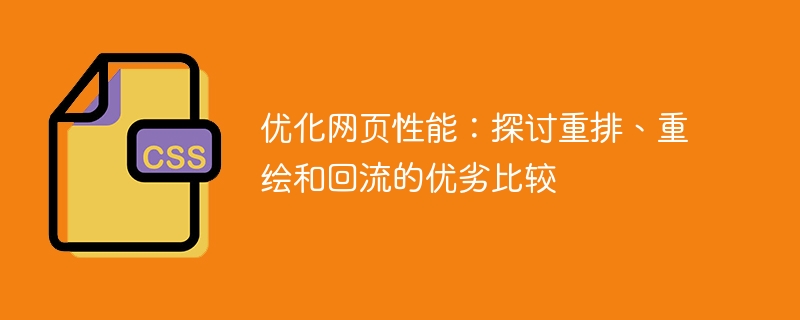

Optimize web page performance: To discuss the advantages and disadvantages of reflow, redraw and reflow, specific code examples are needed
With the development of the Internet, web page performance optimization has become An important question that every front-end developer needs to face. In the process of optimizing web page performance, we need to understand and optimize for different operations. Among them, reflow, redraw and reflow are common problems that lead to reduced web page performance. This article will explore their advantages and disadvantages and give some specific code examples.
First of all, we need to understand the meaning of these three concepts:
Below we use several specific code examples to discuss the advantages and disadvantages of reflow, redraw and reflow.
Example 1:
// 重排 element.style.width = '100px'; element.style.height = '100px'; element.style.left = '10px'; element.style.top = '10px';
In the above code, we modified the layout and geometric properties of the element at the same time, which will trigger reflow and reflow. If we modify each property individually, we will reduce the number of reflows and reflows.
Example 2:
// 重绘 element.style.color = 'red';
In the above code, we only modified the style attribute of the element, which will trigger redrawing but not reflow and reflow. Therefore, the performance overhead of redrawing is small.
Example 3:
// 回流 element.style.width = '100px'; element.style.padding = '10px'; element.style.border = '1px solid red';
In the above code, we modified the layout, geometric properties and style properties of the element, which will trigger reflow. Similar to Example 1, in order to reduce the number of reflows, we can merge multiple modification operations.
To sum up, reflow, redraw and reflow will have a negative impact on the performance of the web page. In order to improve the performance of web pages, we can adopt some of the following optimization strategies:
In short, optimizing web page performance is a comprehensive task. In the actual development process, we need to choose the appropriate optimization strategy according to the specific situation to improve the loading speed and user experience of the web page. At the same time, through the reasonable use of reflow, redraw and reflow techniques, we can reduce the number of these operations and thereby optimize the performance of the web page.
The above is the detailed content of Compare optimization strategies for reflow, redraw, and reflow to improve web page performance. For more information, please follow other related articles on the PHP Chinese website!




